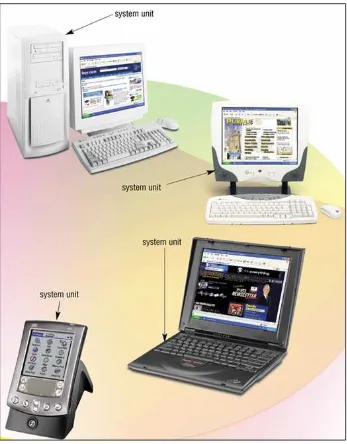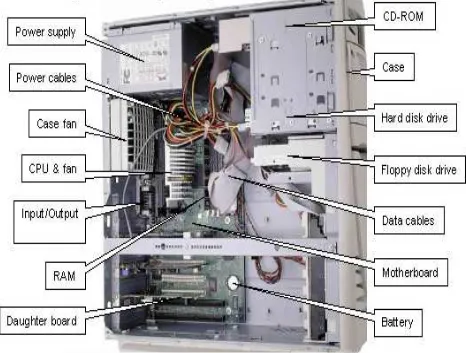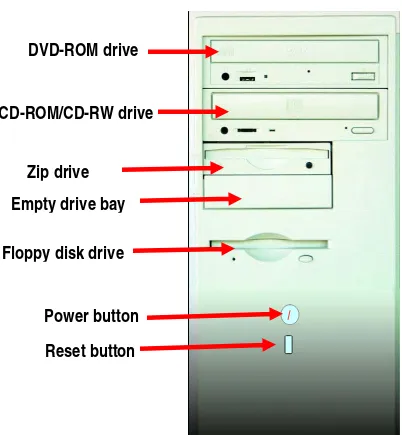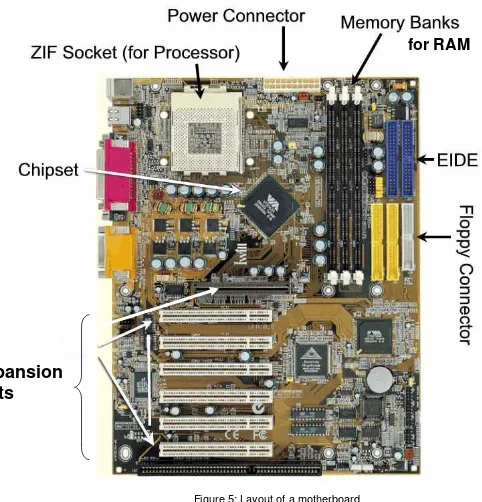K
PUSAT PERKEMBANGAN KURIKULUM KEMENTERIAN PELAJARAN MALAYSIA
MODULE 3
SYSTEM UNIT
1. Name of Module : System Unit
2. Learning Outcomes: The students should be able to:
• identify the components of a system unit
• state the functions of the main components of a system unit
• state the functions of cpu, ram, rom and expansions slots found on the motherboard
3. Knowledge and Skills:
• main components in the computer system
4. Module Summary: At the end of the module, a student is able to :
• identify main components of system unit and motherboard
• state the functions of main components of system unit
• state the functions of CPU, RAM, ROM and expansion slot
This module contains 2 activities:
Activity 1 : Identify the components of a system unit
Activity 2 : Identify the components of a motherboard
Notes: What is system unit?
Box-like case that contains computer’s electronic components
Sometimes called the chassis
Activity 1 : Identify the components of a system unit
Inside view of system unit
Front layer of a system unit
DVD-ROM drive
CD-ROM/CD-RW drive
Zip drive
Floppy disk drive
Empty drive bay
Power button
Reset button
Input/Output port (I/O port)
Functions of the main components of a system unit
No. Components Functions 1. Input/Output port
(I/O port)
A port is the point at which a peripheral attaches to a system unit so that the peripheral can send data to or receive information from the computer.
An external device, such as a keyboard, monitor, printer, mouse and microphone is often attached by a cable to a port on the system unit.
The back of the system unit contains so many ports. Some newer personal computers also have ports on the front of the system unit. Ports have different types of connectors. A connector joins a cable to a peripheral. One end of a cable attaches to the connector on the system unit and the other end of the cable attaches to a connector on the peripheral.
2. Power button To start on computer
3. Reset button Kick of soft boot, instructing the computer to go through the process of shutting down, which would clear memory and reset devices to their initialized state. It simply removes power immediately.
4. Motherboard Main circuit board of the system unit, which has some electronic components attached to it and others built into it.
5. Power Supply Convert standard electrical power into the form that computer can use. If a power supply is not providing the necessary power, the computer will not function properly.
6. DVD-ROM drive A device that reads DVD-ROM, also can read audio CDs, CD-ROMSs, CD-Rs and CD-RWs.
7. CD-ROM drive A device that reads audio CDs, CD-ROMs, CD-Rs and CD-RWs. 8. DVD/CD-RW
drive
It is a combination drive that reads DVD and CD media, it also writes to CD-RW media. This drive also allows watching a DVD or burn a CD.
9. Zip drive A high-capacity disk drive that reads from and writes on a Zip disk. 10. Floppy drive A device that reads from and writes on a floppy disk
Activity 2 : Identify the components of a motherboard
Expansion
slots
for RAM
Expansion
Card
Expansion
Slots
Functions of the components of the motherboard
No. Components Functions 1.
Central Processing Unit (CPU)
A Central Processing Unit or CPU is a microprocessor (or processor for short). It is an integrated circuit chip that is capable of processing electronic signals. The CPU is the most important element in a computer system.
A CPU interprets instructions given by the software and carries out those instructions by processing data and controlling the rest of the computer’s components.
2. Random Access Memory (RAM)
RAM is installed inside computers. RAM is also known as a working memory.
The data in RAM can be read (retrieved) or written (stored). RAM is volatile which means the programs and data in RAM
are lost when the computer is powered off.
A computer uses RAM to hold temporary instructions and data needed to complete tasks. This enables the computer's CPU (Central Processing Unit) to access instructions and data stored in the memory very quickly.
RAM stores data during and after processing. 3.
Read Only Memory (ROM)
ROM is another type of memory permanently stored inside the computer.
ROM is non-volatile. It holds the programs and data when the computer is powered off.
Programs in ROM have been pre-recorded. It can only be stored by the manufacturer; once it is done, it cannot be changed.
Many complex functions, such as start up operating
instructions, translators for high-level languages and operating systems are placed in ROM memory.
All the contents in ROM can be accessed and read but cannot be changed.
4.
Expansion Slots
Worksheet 1
Label the system unit below with the words given.
Expansion Cards
Power Supply Zip Drive Hard Disk Drive Floppy Drive
RAM Mother Board CD/DVD Drive Expansion
Slots
Worksheet 2
Look at the diagram carefully and match them to the name of the ports in the table given using numbers.
No Label of the ports
1
Power port
USB port
VGA port (Monitor display)
Serial port (Modem)
PS2 port (Mouse)
Game port (Joystick)
Audio ports (speaker, headphone and microphone)
Parallel port (printer port)
Worksheet 3
Worksheet 4
Mark T for True and F for False
1. The processor (CPU) interprets and carries out the basic instructions that operate a computer.
2. Computers can use only one processor at a time. 3. ROM is the main circuit board of the system unit.
4. Expansion slot is a socket on the motherboard that can hold an adapter card. 5. RAM is non-volatile
6. The most important chip on the main circuit board is the microprocessor chip. 7. I/O port is the point at which a peripheral attaches to a system unit so that the peripheral can send data to or receive information from the computer.
8. Reset button is to start on computer.
Worksheet 5
Fill in the blank with the correct name of components and functions. No. Components Functions
1. Input/Output port (I/O port)
2.
To start on computer 3.
Reset button 4.
Main circuit board of the system unit, which has some electronic components attached to it and others built into it.
5.
Convert standard electrical power into the form that computer can use.
This drive also allows watching a DVD or burn a CD. 9.
A high-capacity disk drive that reads from and writes on a Zip disk. 10.
Floppy drive 11.
Worksheet 6
Find the differences between primary storage RAM and ROM
Reference
Cashman, S. (2006) Discovering Computers 2006. USA : Thomson Course Technology.
Ibrahim Ahmad, Mohd Hafiz et al (2007) Information and Communication Technology (ICT) Based on SPM Syllabus. Selangor: Venton Publishing (M) Sdn Bhd.
NCC Education (2002) Computer Studies, Computer Ace. Sri Lanka : Computer Pioneers. IBasic Computing (2003) by TMEdu Tech (M) Sdn Bhd
http://www.wikipedia.org




